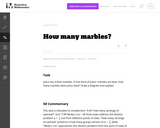
This task addresses the division problem 4Ö1/3.
- Subject:
- Elementary Mathematics
- Mathematics
- Material Type:
- Activity/Lab
- Provider:
- Illustrative Mathematics
- Provider Set:
- Illustrative Mathematics
- Author:
- Illustrative Mathematics
- Date Added:
- 09/14/2012

This task addresses the division problem 4Ö1/3.

This task provides a context for performing division of a whole number by a unit fraction. This problem is a "How many groups?'' example of division.

The focus of the Identifying Fractions on a Number Line intervention is marking, labeling, and naming fractions on a number line. It has two phases that start with a 0 to 1 number line and moves to a 0 to 2 number line.

The purpose of this task is to present students with a situation where it is natural to add fraction with unlike denominators; it can be used for either assessment or instructional purposes.

The purpose of this task is to present students with a context where they need to explain why two simple fractions are equivalent.

This three-act math task utilizes videos and questioning to help students explore multiplying a whole number by a fraction.
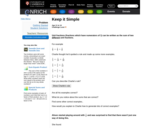
This problem provides an interesting context to consolidate addition of fractions and requires students to develop and analyze different strategies and explain their findings. Students are asked to find a general method for expressing unit fractions (fractions which have numerators of one) as the sum of two different unit fractions. They also explore whether all unit fractions can be written like this in more than one way. The Teachers' Notes page offers rationale, suggestions for implementation, discussion questions, and ideas for extension and support.

This three-act math task utilizes videos and questioning to help students explore multiplying fractions.

Let's Buy a Longboard: Standard 7.NS.3 Solve real-world and mathematical problems involving the four operations with rational numbers. Computations with rational numbers extend the rules for manipulating fractions to complex fractions.
This formative assessment exemplar was created by a team of Utah educators to be used as a resource in the classroom. It was reviewed for appropriateness by a Bias and Sensitivity/Special Education team and by state mathematics leaders. While no assessment is perfect, it is intended to be used as a formative tool that enables teachers to obtain evidence of student learning, identify assets and gaps in that learning, and adjust instruction for the two dimensions that are important for mathematical learning experiences (i.e., Standards for Mathematical Practice, Major Work of the Grade).
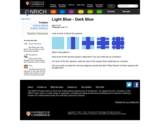
This problem provides students the opportunity to explore fractions in a practical context as well as identify and explain patterns and justify their ideas. Solvers are shown a sequence of five squares shaded light blue and dark blue and are asked to find what fraction of the total area of each square is covered by light blue. They are also asked to work out what the next two squares would look like if they followed the pattern. The Teachers' Notes page offers rationale, suggestions for implementation, discussion questions, and ideas for extension and support.

This is a challenging fraction comparison problem. The fractions for this task have been carefully chosen to encourage and reward different methods of comparison.
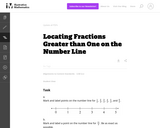
This task requires students to represent fractions on a number line.
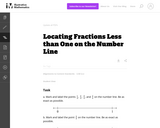
In this number line task students must treat the interval from 0 to 1 as a whole, partition the whole into the appropriate number of equal sized parts, and then locate the fraction(s).
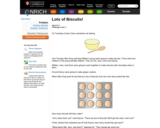
This problem allows students to explore introductory multiplication and division concepts in the context of sharing cookies ("biscuits" in the UK). Cookies are displayed in two different arrays, and students are challenged to divide them equally among two, three, five, and six people and to deal with remainders. The Teachers' Notes page offers rationale, suggestions for implementation, discussion questions, ideas for extension and support, and a printable sheet (pdf).
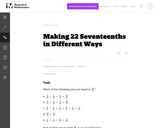
This task is a straightforward task related to adding fractions with the same denominator. The main purpose is to emphasize that there are many ways to decompose a fraction as a sum of fractions, similar to decompositions of whole numbers that students should have seen in earlier grades.

This tasks lends itself very well to multiple solution methods. Students may learn a lot by comparing different methods. Students who are already comfortable with fraction multiplication can go straight to the numeric solutions given below. Students who are still unsure of the meanings of these operations can draw pictures or diagrams.

This problem uses linking cubes as a concrete context for exploring simple multiplication and division, doubling, halves and quarters. The problem displays a rod of 4 cubes and asks students how many cubes are necessary to make rods related to it in a variety of ways. It can be used to introduce key concepts and vocabulary. The Teachers' Notes page offers suggestions for implementation, discussion questions, and ideas for extension and support.

The purpose of this instructional task is to motivate a discussion about adding fractions and the meaning of the common denominator. The different parts of the task have students moving back and forth between the abstract representation of the fractions and the meaning of the fractions in the context.
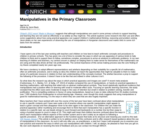
In this article Jenni Back details the use of manipulatives in the mathematics classroom. She describes the results of research studies and her own observations. She draws the conclusion that students need to have various tools available to them and to use them to make sense of the mathematics, not just to follow a rote procedure. Suggestions for ways to implement manipulative use are included in the article.

In this interactive game similar to Concentration(TM) students match fractions (1/2, 1/3, 3/4, and 5/9) to images that represent those fractions. This game can be played in pairs with the printed out cards or as a whole class on the interactive white board (IWB). This resource includes teacher notes with suggestions for introducing the game, discussion questions, support suggestions, a set of cards to be printed (PDF), a blank set of cards to make your own (PDF), and a full screen version of the game.